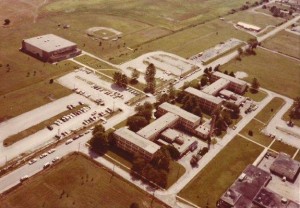By Jesse O. Walls
Assistant Editor
 On Sept. 26, 1965, more than 5,000 people gathered to hear Governor Warren E. Hearnes formally dedicate Crowder College as “a monument not to the past but to the future,” and now, in its 50th year, Hearnes’ words ring more true than ever.
On Sept. 26, 1965, more than 5,000 people gathered to hear Governor Warren E. Hearnes formally dedicate Crowder College as “a monument not to the past but to the future,” and now, in its 50th year, Hearnes’ words ring more true than ever.
Before the College
On May 15, 1941, the first official local announcement for an Army training camp in Neosho was published in The Neosho Times. This military installation would forever change the small Mo. town and would eventually become what is now Crowder College.
The military camp, named after Gen. Enoch Crowder, was to house 35,000 soldiers, and on Sept. 9, 1941, the official groundbreaking was held, according to the book From Camp Crowder to Crowder College by Larry A. James.
The first recruits came to Camp Crowder on Feb. 17, 1942, and for almost two decades the camp would serve as a military post until it’s closing on Feb. 2, 1958. It’s closing, however, left it open so a new dream could be established.
Beginnings
First proposed by R. W. Anderson, the superintendent of the Neosho School District at the time, Crowder College was approved by voters on April 2, 1963, according to the Crowder Call, the first incarnation of Crowder’s official newspaper.
“[Work on a junior college] started in the late 1950s,” said James B. Tatum, Crowder’s longest serving board member, speaking of what went into making Crowder a reality. “We were created in ’63 [after] the law and the legislature were passed in ’61.”
The name Crowder would be selected within two weeks of approval. On Fri., April 12, 1963, the school’s board of directors would choose Crowder because it would be recognizable to many since thousands had trained at Fort Crowder during World War II, stated an article published two days later in the Neosho Daily.
Later in the same year the mascot for the college, the Rough Rider, was chosen. As reported in a 1963 article in the Neosho Daily, the Rough Rider, which was a name bestowed upon members of the 1st
United States Volunteer Calvary during the Spanish-American War, was considered “an appropriate, and unique, tribute to the school’s namesake.”
Classes began on September 8, 1964 for the fall semester, and the first commencement was held on May 27, 1966, at the Neosho Municipal Auditorium, wrote Larry A. James in his book From Camp Crowder to Crowder College.
“It seemed everyone was working hard for the success of Crowder,” said Jack Divine, social science instructor and unofficial Crowder historian. “I think it was [Crowder’s] focus to serve students; all the way from our board of trustees, administrators, faculty and staff.”
More than 360 people were enrolled for the first semester of classes at Crowder, including 276 for day classes and 85 for nights, wrote Bill J. Ball in a 1964 article for the Neosho Daily.
“When the mission statement was developed, I knew that serving had to be in there,” said Tatum, referring to his hopes that Crowder expands on this principle. “We are a community, and I think that’s one of my ‘envisionments’ for the future.”
Since its first semester, Crowder has seen thousands of students pass through its doors, and the future looks promising as enrollment numbers continue to increase by the year.
“Since 2006 I’ve seen Crowder expand considerably,” said Nathan Stillions, business and administration major. “One mark of progress, especially, would be the MARET Center.”
As the college continues to grow and expand, we can truly see that it was “a monument . . . to the future.
